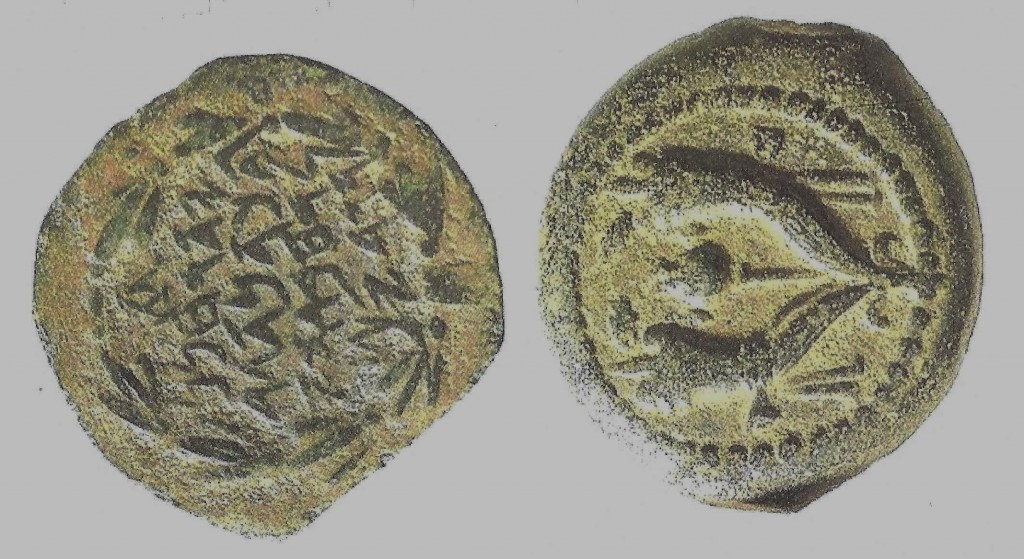03.05.12 Summary Influence of “Hellenistic Reform” (331 – 63 B.C.) that shaped Jewish life in the First Century
The Jewish population throughout the eastern Mediterranean area was so great that they permeated nearly every level of society. While some were accepting of the Greek culture, others were strongly opposed to it. For others, changes toward Hellenism came slowly, and as long as these did not affect the Jewish faith, they did not care. By definition, “Hellenistic reform”[1] was the expected compliance by everyone to the Greek culture, including the acceptance of Greek religious values. And it was the subject of religious values that split the Jewish community.
The claim that the Maccabean Revolt was a revolt against Greek Hellenization is misleading and without historical evidence.[2] The revolt was against the dictatorial monarch, Antiochus IV Epiphanes. The Hellenistic influence greatly affected the Jewish society and, were it not for the Revolt, there is little question that Hellenism would have had an even greater influence. The revolt did, however, cause people to re-evaluate their faith, which in turn resulted in a spiritual revival. But the revival also caused divisions, and after the revolt ended, three major religious parties came into existence: the Pharisees, the Sadducees, and the Essenes. By the time of Christ, Hellenism caused an even wider theological division among the Jews.
The central core of Greek philosophy was that obtaining wisdom was the ideal goal of life. For this reason it has been suggested that philosophy is a false substitute for religion and it stems from the world of paganism which first gave rise to Plato and Aristotle.[3]
Wisdom hath been created before all things, and the understanding of prudence from everlasting.
Ben Sirach 1:4[4]
The Greek gymnasium, theater, and temples were cultural symbols of Hellenistic reform. Except for the gymnasium that was constructed in Jerusalem by Antiochus IV, these Greek icons were not introduced into the Jewish cities until Herod the Great (reigned 37 – 4 B.C.). Many aspects of Jewish life took on the appearance of the Greek culture and were later promoted by the Romans. For example, the Jews wore garments almost identical to the Greeks in Athens, Alexandria, and the Romans wore them in Rome. Their clothing normally consisted of a tunic, cloak, belt, shoes or sandals, and a head covering for both men and women. The headband was the sign of masculinity and never worn by women.[5] Some Jewish men did, however, maintain the tradition of wearing fringes to keep their identity (Num. 15). The Greek custom of reclining at a dining table was precisely what Jesus and the disciples did during the Last Supper. Cultural norms that did not have moral or religious implications were adopted almost universally.[6]
Hellenism had a number of positive and negative influences that are recognized in the New Testament.[7] Galatians 4:4 states that in the fullness of time, Jesus came to earth. God had already been at work for centuries in shaping and preparing it to receive His Son. Some of these influences are as follows:
- In Greek philosophy man is central to life whereas in Judaism God is the central figure.[8] In essence, the Greeks were philosophical while the Jews were theological. Furthermore, the God of the Jews was an invisible deity, who had no “sinful human vices,” and whom they called their Father. This was beyond the comprehension of the Greeks. Their gods and half-gods were formed into idols and had all the human vices and pleasures of humanity. The inability of each group to accept and tolerate the differences of the other resulted in tensions and conflicts in Israel. Interestingly, in Egypt the differences were tolerated and peace prevailed.
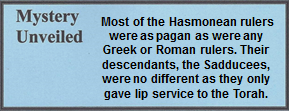
As previously stated, among the Greeks, the idea that a god might appear in human form was accepted in mythology. Little wonder then, that when they heard that Jesus was God, they could accept this fact while the Jews had great difficulty with it. This belief, coupled with the expectation of a messianic figure, explains in part, as to why the Greeks laid their mythologies aside and accepted Jesus. Consequently, Christianity exploded in Gentile nations while it was slow to be accepted, and often opposed, in Jewish communities. The New Testament had to be written in Greek for these new believers.
- The introduction and use of koine Greek was an important development in preparing the world for the gospel.[9] The Roman Empire consisted of a dozen language groups. Had it not been for the invasion of Hellenism, there would have been dozens of language groups.
- There was a profound economic unification in the Mediterranean world, especially in international trade. International trade routes were well established centuries earlier in the days of King Solomon, and even more so after Alexander the Great invaded this area. Therefore, by the time Jesus was born, news traveled quickly by ancient standards. This enabled the gospel to spread quickly throughout the Roman world.
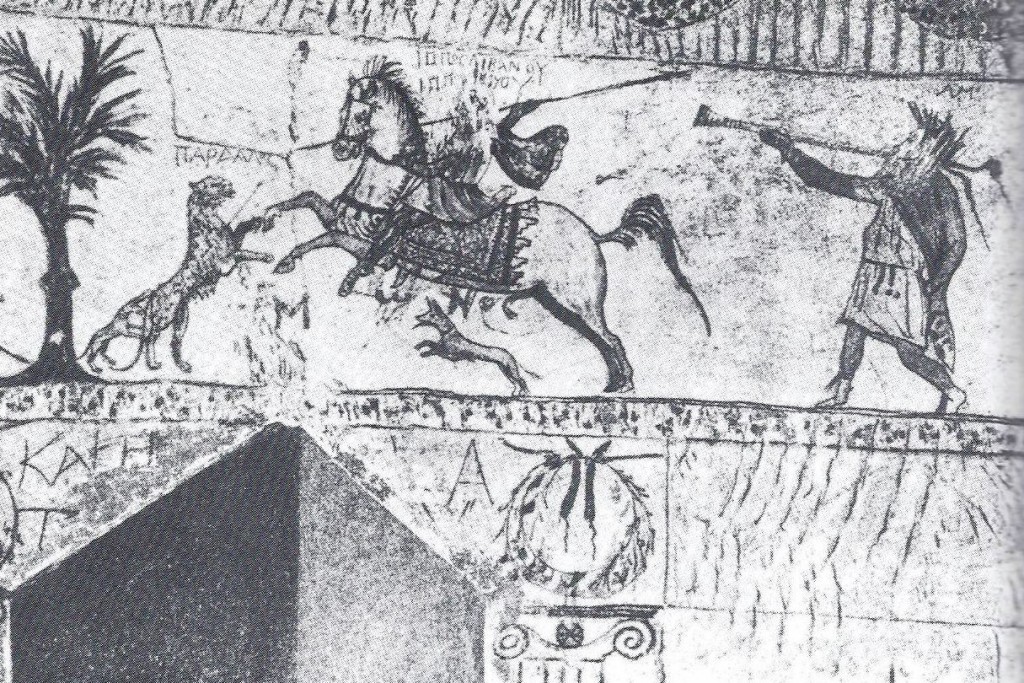
03.05.12.A. HELLENISTIC ART-FRESCO IN A JEWISH TOMB. Evidence of Hellenistic cultural influence in Jerusalem is evident by this Jewish tomb-fresco showing a hunter, herald and lion. In traditional Judaism, the image of a person was banned, but such images became popular with Hellenism.
- Greek logic and thinking, which is foundational in the Western thought processes, is significantly different from how the ancient Jewish people processed information. They thought pictorially. For example, two phrases to describe God in the Old Testament are “tower of strength,” or a “cleft of a rock.” Such descriptions are replaced in the New Testament with words such as “protection,” that have a greater feeling of personal and intimate relationship.[10]
- The Greeks with their philosophical logic and reasoning are generally credited with introducing to the world the question “why?” along with critical thinking. However, Jewish parents had taught their children to ask “Why?” since the first Passover. The question was established as part of the Passover Seder long before it was popular among the Greeks, but the Greeks popularized it throughout the Gentile world.
- Those Greeks who achieved success in life occupied their leisure time with philosophical thoughts, debates, and the like. However, that was a small portion of the population. The earliest form of Christianity was outside the sphere of Greek philosophy, and appealed to those whom philosophy did not reach, which may explain the explosive growth of Christianity among the Gentiles. Philosophers, in the meantime, had very degrading opinions of Christians in terms of philosophy, theology, and socially.
It was common for rabbis, theologians, and philosophers to have debates. In the year A.D. 248, Origen wrote a rebuttal entitled, Against (or Contra) Celsus. In it, Origen quoted this sarcastic attitude by Celsus concerning those who came to faith in Jesus:
Let no educated man enter, no wise man, no prudent man, for such things we deem evil; but whoever is ignorant, whoever is unintelligent, whoever is uneducated, whoever is simple, let him come and be welcomed.
Origen, Against Celsus 3.44[11]
The significance of this lies in the fact that Hellenism, with its focus on philosophy or rhetoric, alienated many people who then, became attracted to Christianity.
- The Greco-Roman culture “set up” as it were, the Gentile people to hear the gospel. They were not only expecting a messiah, but they were also tired of their many gods who had the same human vices as they had. Therefore, some scholars believe that it was Greek philosophy that prepared the Gentile people to receive the concept of Jesus – God in human flesh.[12] The gospel message not only had its own unique merits, but it rode in on the reaction wave against polytheism. This gives added insight to the unique words of Galatians 4:4, that in the “fullness” of time, Jesus came.
- One of the earliest contributions of Hellenism was the translation of the Hebrew Bible into Greek – the Septuagint.[13] By the time Jesus began His ministry, scholars and teachers in the entire ancient world understood Greek and could read a Greek Old Testament to confirm the His words.
Finally, Hellenism also had its negative effects. The cultural and religious threats that challenged young Jews were,
- The loss of Jewish interpretation of the Hebraic details of the Old Testament, the gospels, and possibly the book of Hebrews.[14] In essence, the understanding of Jewish literature as written by Jews in a Jewish context was lost. It gave way to the Greek method of interpretation – often one of allegorical interpretation.[15] That is, the application of a symbolic or spiritual meaning(s) rather than the literal meaning. This would eventually have a huge negative effect on Christian interpretation of Scripture, especially as promoted by Augustine.
- Assimilation into the pagan culture. The youth were always confronted by the pleasures of the Greeks. To them, Judaism was an obstacle that prevented them from finding fulfillment in the so-called “true” pleasures of life. The encroaching influence of Hellenism upon Jewish youth was profound. For example, those Jewish boys who desired to participate in the nude Greek games were embarrassed that they had been circumcised. Everyone obviously recognized their Jewishness. To be accepted by their peers, they underwent a surgical procedure known as epispasm, in which the marks of circumcision were removed. This afforded the opportunity to participate in various Greek athletic events without being identified as Jews.[16] The author of Maccabees called this the “abandonment of the holy covenant,” because God said (Gen. 17:14) that an uncircumcised individual was to be cut off from the Jewish people because he was declared to have broken the covenant. Modern scholarship has often overlooked the negative influences of Hellenism had upon Judaism and the cultural environment of Jesus.
- Due to the tremendous influences of pagan influences, the Jews produced a number of writings that were largely apocalyptic, and often combined with various forms of legalism. These works made frequent references to the great disasters that would fall upon humanity, but that the Jews would be saved by a messiah. Most apocalyptic books were produced starting from the time of Antiochus IV Epiphanes until the second century A.D.[17]
- The worldviews and lifestyles of the Maccabean/Hasmonean rulers, whose descendants became known as the Sadducees, for the most part were as pagan as any Greek or Roman, if not worse. One can debate if their lives reflected the influence of Hellenism or a horribly depraved sin nature (if there is a difference). Nonetheless, most certainly had no interest in faithfully serving their God of Abraham, Isaac, and Jacob.
As previously stated, the Maccabean Revolt began as a rebellion against the paganism of the Greek tyrants. The Essenes and orthodox Pharisees desired to rid their land of Greek influences, but their efforts were minimized by Jewish Hellenists as well as the number of foreigners in the land.[18] It is important to recognize that there were degrees and varieties of reactions against Hellenism, just as there were among those who embraced it. In the meantime, the Sadducees embraced Hellenism as much as they could without causing a popular revolt to have them removed. The Pharisees became entrenched in their Jewish ideologies while the Essenes distanced themselves from both the Sadducees and Pharisees. In fact, all of the Jewish factions became polarized in their doctrines and practices.
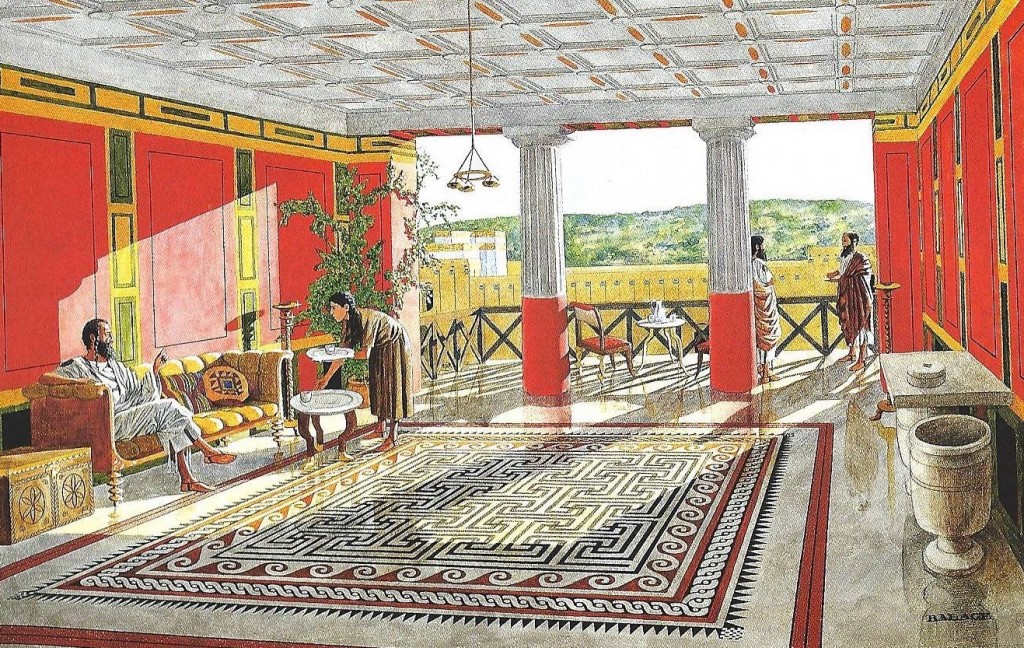
03.05.12.B. AN ILLUSTRATION OF THE HOME OF A SADDUCEE. An artist’s rendering of the home of a wealthy priest in Jerusalem. The Sadducees, who are descendants of the Hasmoneans (Maccabees), including Caiaphas and his family, enjoyed a luxurious life equal to kings and emperors. Their lifestyle was beyond the imagination of the common peasants.
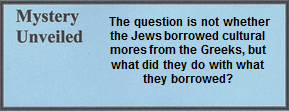
[1]. See also “Hellenism” in Appendix 26.
[2]. Grabbe, Judaism from Cyrus to Hadrian. 308.
[3]. Metzger, ed,. The Apocrypha of the Old Testament. 129; See Appendix 26.
[4]. http://www.ebible.org/kjv/Sirach.htm Retrieved March 19, 2012
[5]. Pilch, The Cultural Dictionary of the Bible. 17.
[6]. Keller, The Bible as History. 356.
[7]. See also 02.04.01-11; 1 Cor. 1.
[8]. See also 02.04.02.
[9]. See 02.03.08 “Language.”
[10]. See 02.03.08 “Language.”
[11]. Cited by Hatch, The Influence of Greek Ideas and Usages. 124-25.
[12]. Hatch, The Influence of Greek Ideas and Usages. 240-41.
[13]. See 02.02.25.
[14]. As is explained elsewhere, the books of Matthew and Hebrews are believed to have been originally written in Hebrew.
[15]. Hatch, The Influence of Greek Ideas and Usages. 59, 66-69, 127-28; See also “Allegory” in Appendix 26.
[16]. Niswonger, New Testament History. 24.
[17]. Guignebert, The Jewish World in the Time of Jesus. 133-35.
[18]. Josephus, at times makes a passing comment on foreigners living in the land, such as their presence in Galilee. See Wars 3.3.2 (41).





